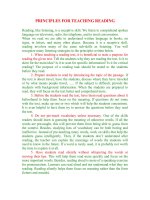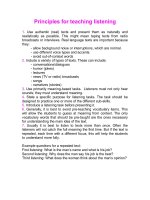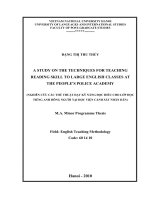PRINCIPLES FOR TEACHING READING
Bạn đang xem bản rút gọn của tài liệu. Xem và tải ngay bản đầy đủ của tài liệu tại đây (61.09 KB, 2 trang )
PRINCIPLES FOR TEACHING READING
Reading, like listening, is a receptive skill. We listen to comprehend spoken
language on television, radio, the telephone, and in sired conversation.
When we read we are able to understand written language in books, on
signs, in letters, and many other places. Because it is a receptive skill,
reading involves many of the same sub-skills as listening. You will
recognize many listening strategies in the principles written below.
1. When teaching a reading text, it is beneficial to state a purpose for
reading the given text. Tell the students why they are reading the text. Is it to
skim for the main idea? Is it to scan for specific information? Is it for critical
reading? The purpose of a reading task should be stated to the students
before they read.
2. Prepare students to read by introducing the topic of the passage. If
the text is about travel, have the students, discuss where they have traveled
or by what means people travel, ….. If the subject is difficult, provide the
students with background information. When the students are prepared to
read, they will focus on the text better and comprehend more.
3. Before the students read the text, have them read questions about it
beforehand to help them focus on the meaning. If questions do not some
with the text, make up one or two which will help the students concentrate.
It is even helpful to have them try to answer the questions before they read
the text.
4. Do not pre-teach vocabulary unless necessary. One of the skills
readers should learn is guessing the meaning of unknown words. If all the
words are pre-taught, this will prevent them from being able to guess from
the context. Besides, studying lists of vocabulary can be both boring and
ineffective. Instead of pre-teaching many words, work on skills that help the
students guess intelligently. Then, if the students don’t understand after
reading, the teacher can explain the meanings of words the students will
need to know in the future. If a word is rarely used, it is probably not worth
the time to explain it at all.
5. Have students read silently without whispering the words or
moving their lips. This will help them read more quickly and focus on the
more important words. Besides, reading aloud is more of a speaking exercise
for pronunciation. Learners can read aloud and not understand what they are
reading. Reading silently helps them focus on meaning rather than the form
(letters and sounds).
6. Discuss difficult vocabulary after reading the text. If they were not
be able to understand certain words or guessing from the context, help them
by explaining the meaning by definition or example.
7. When discussing the answers to comprehension questions, be sure
to refer back to the text often. This will help the students practice finding the
answers themselves, if the teacher always just says the answers, the students
may get into the habit of ignoring what they are reading, instead, ask them
where in the text the answer is.
8. Finally, remember to focus on developing the skills of the readers.
The purpose of teaching reading is not only to help the students understand
the text for that day, but also to help them learn to effectively read for
themselves. To do this, they must develop many sub-skills of reading like
skimming, scanning, predicting, guessing from context, and reading for total
comprehension.









